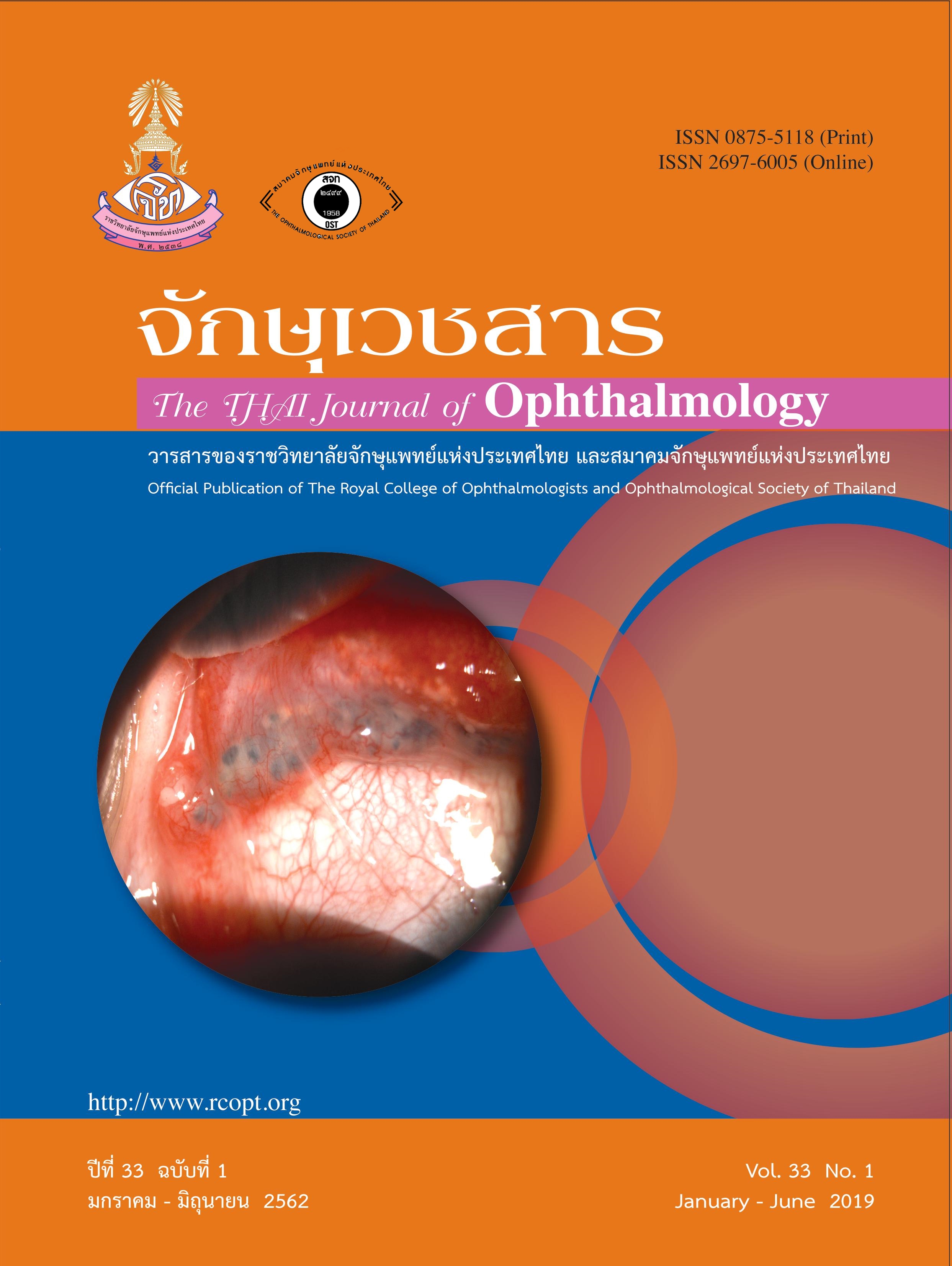ความปลอดภัยของการใช้ยา levofloxaxin ฉีดเข้าในช่องหน้า ม่านตาส่วนหน้าเพื่อป้องกันการติดเชื้อหลังการผ่าตัดต้อกระจก
คำสำคัญ:
Intracameral injection, Levofloxacin, Phacoemulsification, Corneal endothelial cell densityบทคัดย่อ
ความปลอดภัยของการใช้ยา levofloxacin ฉีดเข้าในช่องหน้าม่านตาส่วนหน้าเพื่อป้องกันการติดเชื้อหลังการ
ผ่าตัดต้อกระจก
พรชัย สิมะโรจน์, พ.บ.1, โชติมา อิภิชาติ, พ.บ.1, ภูริชญ์ เพ็ชร์พิรุณ, พ.บ.1
1ภาควิชาจักษุวิทยา คณะแพทยศาสตร์โรงพยาบาลรามาธิบดี มหาวิทยาลัยมหิดล
วัตถุประสงค์ เพื่อศึกษาดูผลของการใช้ยา levofloxacin ชนิดยาหยอดตา ฉีดเข้าในช่องหน้าม่านตาส่วนหน้าเพื่อป้องกันการ
ติดเชื้อหลังการผ่าตัดต้อกระจก ต่อเซลล์บุกระจกตาด้านใน(endothelial cell)
วิธีการ โดยการศึกษาแบบ prospective blocked randomization จำนวน 58 ตา แบ่งเป็น 2กลุ่มคือกลุ่มที่ได้ยา
levofloxacin ชนิดยาหยอดตา (0.5% cravit®) จำนวน 0.1 มิลลิลิตร (มล.) ฉีดเข้าในช่องหน้าม่านตาส่วนหน้า และกลุ่มที่
2 ได้รับสารน้ำ balanced salt solution ขนาดเท่ากัน ฉีดตอนสุดท้ายก่อนปิดแผล โดยบันทึกข้อมูลค่าสายตา ความดันตา
ก่อนผ่าตัด และหลังผ่าตัดที่ 1 เดือน และ 3 เดือน ส่วนค่าความหนาแน่นเซลล์บุด้านในกระจกตา และ ความหนากระจกตา
บันทึกที่ก่อนผ่าตัดปละหลังผ่าตัด 3 เดือน
ผลการศึกษา ผู้ป่วยเข้าเกณฑ์จำนวน 58 ราย แต่มี 43 ราย ที่สามารถรับการตรวจครบตามเกณฑ์ที่กำหนด ที่ 3 เดือน ค่าสายตา
ความดันตา ความหนากระจกตา และค่าเฉลี่ยการลดลงของเซลล์บุกระจกตาด้านในระหว่างกลุ่มไม่มีความแตกต่างอย่างมีนัย
สำคัญทางสถิติ (p > 0.05) โดยการลดลงของเซลล์บุกระจกตาด้านในคิดเป็นร้อยละ 17.25 ในกลุ่มที่ฉีดยา levofloxacin (22
ราย) เทียบกับลดลง ร้อยละ 12.19 ในกลุ่มเปรียบเทียบ (21 ราย) p=0.108 ไม่พบภาวแทรกซ้อนและการติดเชื้อในการศึกษานี้
สรุป การใช้ยาหยอดตา 0.5% levofloxacin (cravit®) ขนาด 0.1 มิลลิลิตร ฉีดเข้าช่องม่านตาส่วนหน้า อาจเป็นทางเลือกหนึ่ง
ในการป้องกันการติดเชื้อหลังผ่าตัดต้อกระจก
เอกสารอ้างอิง
ESCRS Endophthalmitis Study Group. Prophylaxis of postoperative endophthalmitis following cataract surgery: results of the ESCRS multicenter study and identification of risk factors. J Cataract Refract Surg 2007; 33: 978-88.
Seal DV, Barry P, Gettinby G, Lees F, Peterson M, Revie CW, et al. ESCRS study of prophylaxis of postoperative endophthalmitis after cataract surgery: Case for a European multicenter study.J Cataract Refract Surg 2006; 32: 396-406.
Barry P, Seal DV, Gettinby G, Lees F, Peterson M, Revie CW. ESCRS study of prophylaxis of postoperative endophthalmitis after cataract surgery: Preliminary report of principal results from a European multicenter study. J Cataract Refract Surg 2006; 32: 407-10.
Espiritu CR, Caparas VL, Bolinao JG. Cesar Ramon G. Safety of prophylactic intracameral moxifloxacin 0.5% ophthalmic solution in cataract surgery patients. J Cataract Refract Surg 2007;33:63–68.
Arbisser LB. Safety of intracameral moxifloxacin for prophylaxis of endophthalmitis after cataract surgery. J Cataract Refract Surg 2008; 34:1114–20.
Lane SS, Osher RH, Masket S, Belani S. Evaluation of the safety of prophylactic intracameral moxifloxacin in cataract surgery. J Cataract Refract Surg 2008; 34:1451–9.
Matsuura K, Miyoshi T, Suto C, Akura J, Inoue Y.. Efficacy and safety of prophylactic intracameral moxifloxacin injection in Japan. J Cataract Refract Surg 2013; 39:1702– 6
Simaroj P, Sinsawad P, Lekhanont K. Effects of intracameral Triamcinolone and Gentamicin injections following cataract surgery J Med Assoc Thai 2011; 94 (7):819-25
Mamalis N, Edelhauser HF, Dawson DG, et al. Toxic anterior segment syndrome. J Cataract Refract Surg 2006; 32:324–33.
Kim SY, Park YH and Lee YC. Comparison of the effect of intracameral moxifloxacin, levofloxacin and cefazolin on rabbit corneal endothelial cells. Clinical and Experimental Ophthalmology 2008; 36: 367–70.
Choi JA, Chung SK. Safety of intracameral injection of Gatifloxacin, Levofloxacin on corneal endothelial structure and viability. J Ocul Pharm Ther 2009; 25:425-31.
Uda T, Tasaka Y, Kawasaki S, Mito T, Suzuki T, Uno T, et al. The evaluation of intracameral injection of Levofloxacin in the prophylaxis of postoperative Enterococcus Faecalis Endophthalmitis. Investigative Ophthalmology & Visual Science April 2010, Vol.51, 2902-.
Sakarya Y, Kurku H, Sakarya R, Ozcimen M, Kara S. Free radical content of drugs used in ophthalmology. Eur J Gen Med 2012; 9(2):85-90.
Lockington D, Macdonald ECA, Young D, Stewart P, Caslake M, Ramaesh K. Presence of free radicals in intracameral agents commonly used during cataract surgery. Br J Ophthalmol 2010;94:1674 -7.
Berry P, Cordovés Land Gardner S. ESCRS Guidelines for Prevention and Treatment of Endophthalmitis Following Cataract Surgery: Data, Dilemmas and Conclusions 2013. published by the European Society of Cataract and Refractive Surgeons, Temple House, Temple Road, Blackrock, Co Dublin, Ireland. www.escrs.org
ดาวน์โหลด
เผยแพร่แล้ว
ฉบับ
ประเภทบทความ
สัญญาอนุญาต
The Thai Journal of Ophthalmology (TJO) is a peer-reviewed, scientific journal published biannually for the Royal College of Ophthalmologists of Thailand. The objectives of the journal is to provide up to date scientific knowledge in the field of ophthalmology, provide ophthalmologists with continuing education, promote cooperation, and sharing of opinion among readers.
The copyright of the published article belongs to the Thai Journal of Ophthalmology. However the content, ideas and the opinions in the article are from the author(s). The editorial board does not have to agree with the authors’ ideas and opinions.
The authors or readers may contact the editorial board via email at admin@rcopt.org.


